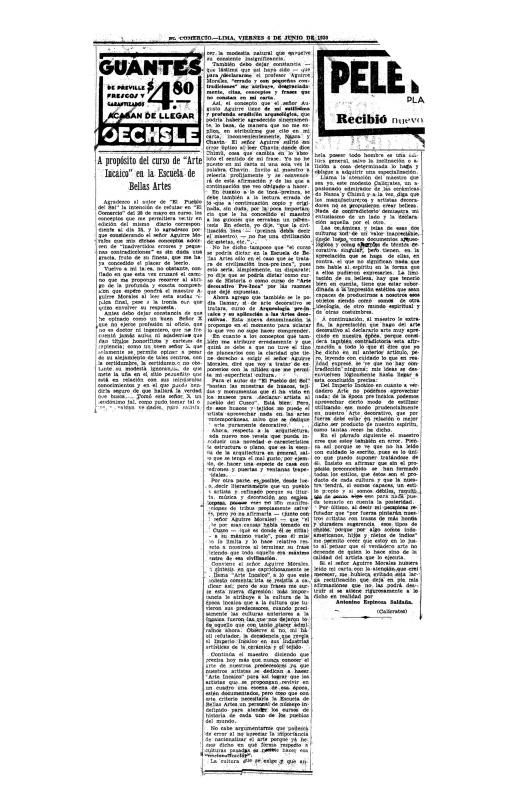In April 1930, in the context of an increasingly nationalist atmosphere amongst Peruvian intellectuals, the Escuela Nacional de Bellas Artes in Lima launched the course “Incan art.” The course was entrusted to Augusto Aguirre Morales (1888–1957), a writer famous at that time for his novel El pueblo del Sol (1924 and 1927)—an idealized account of life in the Tahuantinsuyo or the Inca Empire. While the course’s contents, like its title, suggest a largely literary approach, it attempted to uphold the pre-Columbian tradition as the basis for a “national” art. The course’s pertinence for the professional education of painters, however, was undermined by the ornamental revivalist logic underlying most appropriations of the pre-Hispanic. Along those lines, painter Antonino Espinosa Saldaña questioned not only the overly general name of the course, but also the transcendence of pre-Columbian art itself and its influence on Peruvian “fine arts.” [For additional information, see by Antonino Espinosa Saldaña the following articles in the ICAA digital archive: “Ensayo sobre la estética del arte pre-colombino” (doc. no. 1143685), “A propósito del curso de ‘arte incaico’ en la Escuela de Bellas Artes” (doc. no. 1143553), and “A propósito del curso: carta abierta (doc. no. 1143520)]. In an attempt to define national identity in strictly Western terms, Espinosa Saldaña aimed his criticisms at those who considered the indigenous (past or present) and the “Peruvian” one and the same. While Aguirre Morales’s arguments placed pre-Columbian art in the terrain of the decorative arts or of historicist painting, they upheld it as an example of harmony between man and his environment. Aguirre Morales considered the indigenous the sole “legacy” capable of giving shape to a specifically “Indo-American” identity.
The debate continued not only in the essay written by Espinosa Saldaña (1888–1969), but also in other responses to the two letters resulting from a call for opinions intended to be published as a booklet (that project never came to fruition), responses sent by a range of intellectuals and artists. The fact that painter José Sabogal (1888–1956) did not participate in the exchange attests to Indianism’s emphasis on the ethnographic. Participants in the debate included architect Héctor Velarde (1898–1989) and Mariano Ibérico (1892–1974).



